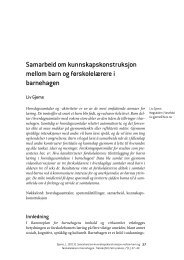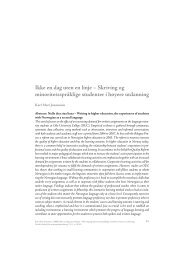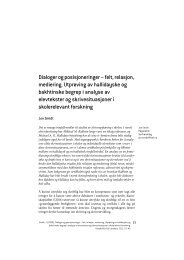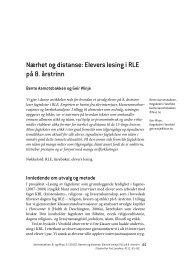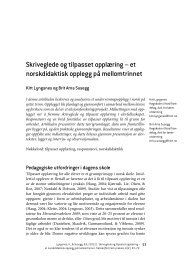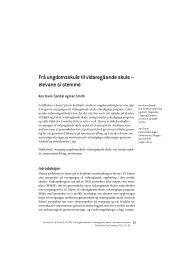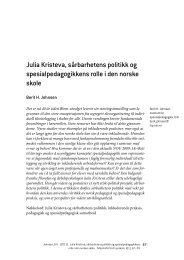AN ESSAY ON SPIRITUALITY OF HOMO LUDENS URBANUS
AN ESSAY ON SPIRITUALITY OF HOMO LUDENS URBANUS
AN ESSAY ON SPIRITUALITY OF HOMO LUDENS URBANUS
- No tags were found...
You also want an ePaper? Increase the reach of your titles
YUMPU automatically turns print PDFs into web optimized ePapers that Google loves.
Pasi Mäenpää: An essay on spirituality of homo ludens urbanusnent and generalised ability to think and act in a way we can call ethics. Here the reasoningfollows pragmatist epistemology where action and knowledge are seen as part of thesame process of the practises. Consumption is considered a constitutive way of being inthe world and as such it has effects on consumer-urbanites’ religiousness and spirituality,as well. In a bigger picture, the approach suggests that spirituality is no longer bound tolabour and production but rather to leisure and consumption.Since I am not too familiar with sociology of religion, I will not refer to earlier studiesin this field, nor will I comment widely earlier scientific findings in Finland or elsewhereabout modern religiosity. The exception is the discussion on secularisation and how itleads to people leaving the main Finnish church, which I will use as a reference point fordiscussion. The idea is simply to bring the sociological findings of urban consumption tothe fore of religiousness and spirituality, and to try to make sense of some cultural phenomenaboth at the side of consumption and that of religiousness. Implicitly this approachtends to cross and blur the boundary between those to spheres – which I assume is oftenthe case in the sociology of religion and religious studies.Playful practises of public spacesPlay is classically defined as free, separated, unproductive activity, which is governedby rules. Furthermore, the result of play is always uncertain and mentally it is based onthe logic of make-believe, which means that it is «accompanied by a special awarenessof a second reality or of a free unreality, as against real life». (Caillois 1961: 9–10.)Play is free activity standing quite consciously outside the realm of ‘ordinary’ life asbeing ‘not serious’, but at the same time absorbing the player intensely and utterly(Huizinga 1984). Play is a self-purposeful (autotelic) and autonomous, imaginedsphere in reality which aims at joyfulness and entertainment. It is an artificial worldinside the world.To put a long ethnographic story short, two main aspects prevail in modern urban andoften consumeristic experience. They are unexpectedness and make-believe. That is whyI call the urban play an aleatory-mimetic one. ‘Aleatory’ signifies the mental activity ofadjusting the unexpectedness of urban life. ‘Mimetic’ refers to the idea of city as theatrummundi, a worldly theatre where people are at stage presenting themselves to eachother. Both of these aspects have been considered key factors of urbanity by many scholarsand writers (e.g. Goffman 1967; Sennett 1977; Hannerz 1980).The interconnecting concept between play and religion is ritual. Ritual can be definedas a myth realised. Myths, for one’s part, are main elements of religions, though all themyths are not exactly religious. The conceptual analysis of all these is not possible here.It is sufficient to say, that play and playfulness differ from ritual at least in four senses: 1)play is not necessarily bound to mythology, 2) play is not necessarily bound to time, 3)play is free and not sanctioned, and 4) play does not necessarily produce anything to theworld outside its own realm, as ritual as rites of passage usually do. Play seems to bemore profane and free of institutionally shared beliefs than ritual, though play is always3



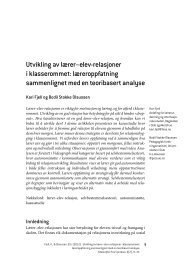
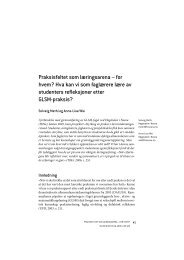
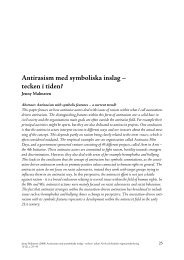
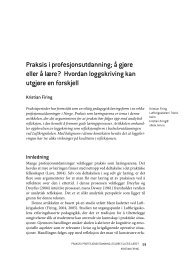
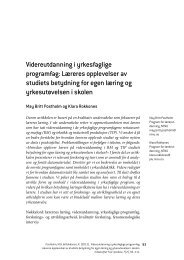
![Hvordan skal jeg […] utvikle meg selv? - Tapir akademisk forlag](https://img.yumpu.com/47976067/1/184x260/hvordan-skal-jeg-utvikle-meg-selv-tapir-akademisk-forlag.jpg?quality=85)
